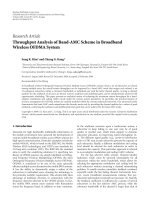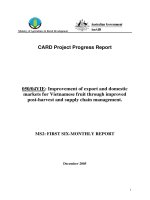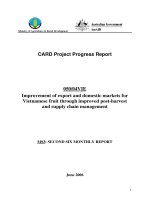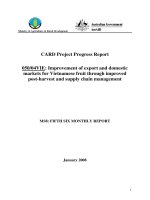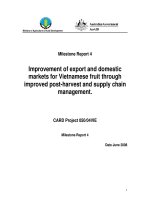Improvement of order processing scheme in Fuji xerrox Viet Nam supply chain management
Bạn đang xem bản rút gọn của tài liệu. Xem và tải ngay bản đầy đủ của tài liệu tại đây (2.12 MB, 57 trang )
1
By Phan Viet Hong MBQPM4 Final Project
HO CHI MINH CITY OPEN UNIVERSITY UNIVERSITÉ LIBRE DE BRUXELLES
SOLVAY BRUSSELS SCHOOL OF
ECONOMICS & MANAGEMENT
MBQPM4
PHAN VIET HONG
IMPROVEMENT OF ORDER PROCESSING
SCHEME IN FUJI XEROX VIETNAM –
SUPPLY CHAIN MANAGEMENT
MASTER FINAL PROJECT
MASTER IN BUSINESS QUALITY AND PERFORMANCE MANAGEMENT
Ho Chi Minh City
(2014)
3
By Phan Viet Hong MBQPM4 Final Project
Statement of authentication
This project is about Fuji Xerox Vietnam - Supply Chain Management operations.
The project named “improvement of order processing scheme” is developed and
completed by Phan Viet Hong - student of MBQPM4 (2012) class in the final
project of Master Degree.
This individual study is based on actual scenarios of SCM operations in Fuji Xerox
Vietnam. By finding the operations issues and developing the countermeasures base
on PDCA cycle, the project helped the SCM team in FXV to improve some specific
weak areas and also to suggest further countermeasures for improvement in the
future
4
By Phan Viet Hong MBQPM4 Final Project
Acknowledgements
I highly appreciate to the classmates in the group: Ms. Phuong Hanh, Ms. Yen Phuong,
Mr. Van Binh, Mr. Van Thuy in class MBQPM4 (2012) who support me a lot during
the time of the course, this group is very effective in many group assignments that we
worked together.
I would like to have special thanks to Professor Martin for giving me knowledge in the
classes, providing guidance and answering to my questions and concerns during the
time I do the final project.
I also have special thanks to related managers and staff working in Fuji Xerox Vietnam
for giving me the data, explanation in department operations and also sharing good
ideas for me to complete the final project.
I appreciate some Fuji Xerox HQ staff located in Singapore working in IM and SCM
department for supporting me to speed up the action implementation, without their kind
support, we are unable to meet the dead line of the project and also cannot see the
result as of today.
5
By Phan Viet Hong MBQPM4 Final Project
Table of Contents
CONTENTS
Page
PREFACE
8
PART 1: FUJI XEROX VIETNAM AND ITS SCM OPERATIONS
9
Chapter 1: FXV Introduction
9
1.1 Company profile
9
1.2 Organization Chart
11
1.3 FXV SCM Operations introductions
12
1.4 SCM current Process Overview
14
Chapter 2: Investigation of problem in FXV SCM
16
2.1 Inventory management (planning under SCM)
16
2.2 Support Logistics
16
2.3 Processing time of Indirect sales orders
17
2.4 Problem solution selection
19
Chapter 3: Review of Problem for improvement of SCM in FXV
21
3.1 Review current process to get understanding the current status
21
3.2 Setting the target for improving
24
PART 2: IMPROVEMENT OF ORDER PROCESSING SCHEME IN FXV SCM
29
Chapter 1: Countermeasures development
29
1.1 Low forecast accuracy (sales)
29
1.2 Low cooperate attitude from distributors
30
1.3 Job runs at low speed in system
31
1.4 Manual workflow in order process
34
1.5 Evaluation and selection for the countermeasure
35
1.6 Develop countermeasures and deploy actions (action plan to improve)
36
Chapter 2: Measure the results and compare to the targets
45
Chapter 3: Re-engineer and Standardize the process
49
3.1 Objectives and scope
49
3.2 PO Overview
49
3.3 Deliver
49
3.4 Process details
50
3.5 Further suggestion for improvement
53
CONCLUSION
57
Reference
58
6
By Phan Viet Hong MBQPM4 Final Project
List of abbreviations
CCA
Call Centre Agent
HCM
Hochiminh
ALC
Asia Logistic Centre
HFSI
High Frequency Service Items
AR
Account Receiveables
IM
Information Management
AWMS
Apeos Ware Management Suite
ITSS
This is an IT system of FXV
APO
Asia Pacific Operations
IT
Information Technology
CON
Consumables
NEI
Non Equipment Inventory
CRM
Customer Relationship Management
OPB
Office Product Business
CS&Q
Customer Service & Quality
PDCA
Plan Do Check Act
DOS
Days of Sales
PC
Personal Computer
EI
Equipment Inventory
PO
Purchase Order
FXV
Fuji Xerox Vietnam
PSB
Production System Business
FSMA
Full Service Maintenance Agreement
SCM
Supply Change Management
FY
Japanese Fiscal Year (1 Apr – 31 Mar)
SMC
Senior Management Committee
HN
Hanoi
SP
Spare Parts
HR
Human Resources
3PL
3
rd
Party Logistic
7
By Phan Viet Hong MBQPM4 Final Project
List of Pictures
Picture 1: Xerox network in the world
Picture 23: Structure of Proxy Server in
HCM and HN office
Picture 2: FXV business scheme
Picture 24: Structure of Internet Leased
line
Picture 3: FXV Organization Chart
Picture 25: Current issue of limited
bandwidth
Picture 4: Customer Service & Quality
Organization Chart
Picture 26: Evaluation and selection of
countermeasures
Picture 5: SCM process
Picture 27: Internal team meeting
Picture 6: DOS report of Equipment
Picture 28: Task schedule and due date
Picture 7: Sample of consumables order
taking from CCA to SCM
Picture 29: Task schedule and duration
Picture 8: Revenue contribution by direct
and indirect
Picture 30: Comparison before and after
installed Proxy Server
Picture 9: Current indirect sales Order
process
Picture 31: Dry run Order process
Picture 10: Sample of cancel sales order
Picture 32: Eliminate step 3
Picture 11: Problem summary
Picture 33: Key performance index to
monitor performance of Dealers
Picture 12: Selection of the issues for
resolution
Picture 34: Key Roles and Responsibilities
Picture 13: Current indirect sales Order
process
Picture 35: Launched forecast policy
Picture 14: Current lead time for direct and
indirect sales Order
Picture 36: Compare the old and new
process
Picture 15: Number of dummy order in
FY13
Picture 37: Results of order from Apr-
May‟14
Picture 16: Time consuming in each steps
in FY13
Picture 38: Dealer Feedback Improvement
Picture 17: Identify the target for
improving areas
Picture 39: Correct order contents
comparison
Picture 18: Target setting for the
improvement
Picture 40: Results after implementation of
new process
Picture 19: Fishbone analysis
Picture 41: Time Results after
implementation of new process
Picture 20: Team survey for evaluation the
causes
Picture 42: Current status of Dealer
outstanding Account Receivables
Picture 21: sample of forecast form
Picture 43: New standardized indirect sales
order process
Picture 22: Forecast scheme
8
By Phan Viet Hong MBQPM4 Final Project
Preface
This project is based on actual scenario and actual data collected from FXV SCM
operations. None of the text in the project is taken from any previously published
project
All the SCM operations including current process are illustrated in chapter 1 that is
referred to the process collected by SCM team, company process.
Chapter 2 is the investigation of some keys problem happening in FXV SCM that can
be resolved in short term, it is very obvious issue in daily operations, I am not trying to
touch the big issue which is very general that may be out of the scope or need long time
to resolve it. For example changing the supply vendor or outsourcing some
operations… base on 3 selected problems, I chose the problem to resolve in this project
that is most feasibility and can help the current operations. Chapter 3 is to review the
current status and setting the target for improvement.
Part 2 is focused mostly on countermeasure developments and implements the action
plan to resolve the problem. After the actions are taken, the result is measured and
compared to the target to see the improvement. Once it is confirmed that
countermeasures are confirm to work and help the operations, chapter 3 of part 2 to
explain about re-engineering and standardizing the process and document it.
To continuous follow up and improvement, I have some further suggestion for the
operations to improve in longer term in last chapter of part 2.
The entire project was done within FXV SCM scope using systematic thinking, data
analysis and QC tools. The data in the project is Confidential and not Published.
9
By Phan Viet Hong MBQPM4 Final Project
PART 1: FUJI XEROX VIETNAM AND ITS SCM
OPERATIONS
Chapter 1: FXV Introduction
1.1 Company profile
Fuji Xerox Co., Ltd. has been established in 1962 as a joint venture between Xerox
Limited and Fuji Photo Film Co., Ltd. The Company oversees Group activities in South
Korea, Taiwan, the Philippines, Indonesia, Thailand, Australia, New Zealand,
Singapore, and Malaysia.
Picture 1: Xerox network in the world
Fuji Xerox Vietnam (FXV) is established in 05/2010 aiming at business expansion in a
rapidly growing market in Vietnam. The establishment of FXV not only reinforces the
activities of the dealers, but also enables direct sales and direct maintenance services
operations, which will satisfy demands from customers who expect even higher value
in products and services.
Company products:
10
By Phan Viet Hong MBQPM4 Final Project
Currently, FXV is providing 3 kinds of main photocopy multi-function product
including the network and personal printers (OPS), Office multi-function machines
(OPB) and High end production printers (PSB).
Beside, FXV is also selling office software product such as Docuworks, AWMS,
Docushare and paper as the newly established business in the year 2014. The main
revenue come from box selling to direct and indirect end user and also from the service
that called “click charge” revenue which the customer sign full service contract with
FXV and just pay bill base on how many pages they prints per month that later call in
this project Full Service Maintenance Agreement or FSMA.
Company business structure
FXV is currently doing business directly and indirectly with end customer, there are 6
distributors in Vietnam and 2 Dealers in Cambodia under indirect sales, these channels
also have their own sales and service team. FXV just provide support to Distributors
such as marketing support, technical support but without touching their end customers.
In the designed stage when company is establishment, to avoid business confliction
with current Distributors, FXV just sell their products to “new customer”, “global
customer” that they found and they also will service those machines for after sales
service. With the current customers who want to buy additional machines, FXV will
have to introduce to Distributors. If current customer want FXV to service their
machine, FXV has to refuse and inform to Distributors for more handling. If the
customer still wants to buy from FXV and do not want to buy from Dealer, in this case,
FXV must install the machine and service it but FXV has to pay some amount of
money to Dealer in so called Alliance scheme.
Below is the summary of scheme FXV provide direct service to its own customer:
Picture 2: FXV business scheme
11
By Phan Viet Hong MBQPM4 Final Project
1.2 Organization Chart
Picture 3: FXV Organization Chart
In the company, the president is legal representative and under the president are
department head who are also members of Senior Management Members or SMC (in
blue box). This is the management board of the company who has responsibility to
issue company policy, monitor the company financial performance and decides the
direction and business strategy for the company.
The organization has 3 direct Sales Operations: North sales operations, South sales
operations 1, South sales operations 2. These sales teams will directly find customers
and sell the products. These teams are in charge of selling OPB or office products
including OPB equipment and OPB software that most of the office is using now for
office environment.
Productions system business (PSB) provides direct sales for production machines.
These are the very big machines that mostly target to printing house, commercial print
customer, print on demand or minilab who makes the photo book.
Channel business group is in charge of indirect business or channel business, they are
looking after the Dealers which has another name called Authorized Distributors.
These Dealers also has their direct sales and service, they are independent in finance
and mostly are exclusive Dealers that are supposed to sell only Fuji Xerox Products.
12
By Phan Viet Hong MBQPM4 Final Project
Back office is Customer Service and quality department, Marketing department,
Finance department and HR department. These departments do the support to
mentioned before sales departments. Regarding to customer server, there are 2 main
teams located in Ho Chi Minh and Hanoi which are responsible for customer in the
South and North
Picture 4 Customer Service & Quality Organization Chart
SCM currently is under Customer Service & Quality department headed by Viet Hong
– GM of CS&Q. The reason why company put SCM under CS&Q is that SCM will
have more collaboration with Customer Service to support internal and external
customer towards to more customer satisfactions.
Hoang Xuan is currently SCM manager leading 6 staff; they are in charge of all SCM
matter in FXV including Hanoi, HCM and Cambodia Dealers. There 5 members
located in Ho Chi Minh office and 1 in Hanoi
1.3 FXV SCM Operations introductions
FXV SCM overview consists of planning (supply & demand), logistics, distributions,
customer service. As first role in supply chain, supply demand planning is an important
part. Responsibility is balancing inventory level and fulfillment ratio, forecast
13
By Phan Viet Hong MBQPM4 Final Project
accuracy. So, this project scope is pointing out ordering processing scheme
management for improvement.
Every organization including productions, sales or trading of products need to hold
inventory. While production organizations hold raw material inventories, finished
goods and spare parts inventories, the trading companies hold only finished goods
inventories. FXV is operating as trading and servicing company so it builds the
inventories with finished goods to satisfy customer demand and trying to reduce sales
management and ordering costs, stock out costs and reduce transportation costs and
lead times.
In order to manage healthy inventory, SCM sets up policy for inventory level,
economic order quantity and periodic ordering, so the elements being for inventory
management such as holding plan, transit times and order management lead times etc
are important or how to achieve customer satisfaction and demand fulfillment.
Inventory level is considered based on inventory plan or target and stock keeping units
is reviewed “Fast Moving” defined by Green zone, “Slow Moving” – Yellow zone &
“Non Moving”- Red Zone. The color of the zone indicating their frequency and
volume of sales.
Economic order quantity and periodic ordering which deals with inventory planning
and being inventory tracking. As inventory planners, their main job consists in
analyzing demand and deciding when to order and how much to order new inventories.
In FXV, based on result of sale outlook meeting, SCM planner will calculate purchase
order and propose purchase order quantity (consideration: Operation plan, Finance
outlook, sale outlook number, inventory policy, average usage (historical trend) and
bulk deal)
With conditions are stable supply capacities from head quarter, centralized warehouse
in Singapore, FXV can maximize forecast result, and it means that FXV can get
enough stock whenever it places order within forecast number, FXV can develop
planning logic as following:
Buffer/Safety Stock: is the quantity that can cover 3 weeks sale out (latest 3 months
average usage) because lead time of order is 3 weeks.
Equipment:
PO quantity = (buffer/safety stock + Sale outlook) – stock on hand (including in
transit)
Consumable (Toner and Drum):
14
By Phan Viet Hong MBQPM4 Final Project
PO quantity = (buffer/safety stock + Max 3M usage) – stock on hand (including in
transit)
In terms of measuring a sales performance in relation to Inventory, FXV often uses the
term “Inventory Turnover”. Inventory turnover refers to the number of times the
inventory is sold or used in a period of one year. Inventory turnover is also termed as
stock turn which is measured by unit is DOS (Day of Sale):
DOS = value of inventory end of month / average past 6 month cost of
goods sold x 30 days.
A higher inventory turnover (low DOS) indicates a healthy trend of increased sales and
indicates the need to maintain adequate inventory levels to avoid stock outs. Inadequate
stocks can result in loss of business opportunities that SCM needs to keep watching
closely. On the other hand a lower inventory turnover (high DOS) shows that either the
sales of the said inventory which is slowing down or that the unused inventory is
building up somewhere. A slow inventory turn can help the inventory manager focus
on finding non-moving, obsolete and slow moving inventory items and thereby steps
can be taken such as notification to sale to find out opportunity or request marketing to
develop clearance program.
1.4 SCM current Process Overview:
Equipment (EI), Consumables (Con) and Spare Part (SP) are manufactured from Japan
and China shipped to FXAP/ALC hub. This centre receives order from FXV and
fulfills the order in 2 ways:
If the order is for Distributor, the shipment will be from ALC directly to Distributor
warehouse in HCMC or Hanoi warehouse (these warehouse are under Distributor and
FXV have no any management of these warehouses)
If the order is for FXV end customer, the shipment will be from ALC to HCMC 3PL
warehouse located in Binh Duong province.
In FXV, there are 4 warehouses. 2 big 3rd party warehouse located in Binh Duong and
Quang Minh (Hanoi); 2 small warehouses called depot warehouse located in FXV
HCM and HN office to store HFSI parts and Consumables, not equipments.
Transportation for delivery, EI and Con using truck with 1 day lead-time and SP using
Motorbike with 2-4 hours lead time.
15
By Phan Viet Hong MBQPM4 Final Project
Picture 5: SCM process
SCM scope:
FXV is not responsible for purchasing products from manufacturers in
Japan, China or Thailand, so FXV just partially handle the supply chain in the “
red dot
line” from FXAP/ALC hub to end customer. We understand that FXV not fully
manage it supply chain from vendor (manufactory) to FXAP/ALC down to the
customer, FXV just handle the order from ALC down to its end customer.
This paper is to investigate the situation in FXV SCM operations mentioned above,
analyze it and recommend the solutions to improve its quality in the organization.
Especially, FXV doesn‟t control all the stage in the SCM.
16
By Phan Viet Hong MBQPM4 Final Project
Chapter 2: Investigation of problem in FXV SCM
2.1 Inventory management (planning under SCM)
Base on the current process, SCM makes order base on the outlook number and plus
some buffer to avoid the sudden order from sales, there is no big issue in supply so far
with this logic when order and how many quantity order because SCM allow sale staff
direct verbal booking to SCM to adjust order timely. However not all the sales have
exact sell out as by model what they committed in monthly outlook. Some outlook
model belong to very slow turnover sale, this lead to long inventory issue whenever
sale outlook come inaccuracy falling on slow turnover model. Below DOS report of
Inventory as of Apr 2014 show high warning zone area.
Note: High means „more than 360 days or from 1 year to 3 years
Picture 6: DOS report of Equipment
We can address that there are inventory stay in the warehouse without any movement
which are in danger zone 1,2 about 1.8% and slow moving status in warning zone as
22.8%. This means planning purchase rely on outlook number doesn‟t work well. So,
the inventory build-up is very expensive and could lead to obsolete in one day if it is
not managed well. How to improve this area is still the issue in SCM
2.2 Support Logistics
FXV has a strong service team, supporting more than 2000 machines in customer.
Besides the monitoring service quality, service team also help company improve the
Age of Inventory (days) ->>
DOS (Days)
Infinity
5.90% 10.58% 0.08% 1.52%
High DOS
8.30% 1.65% 2.17% 0.14%
180
1.11% 0.07% 8.16% 0%
120
5.35% 0% 0.13% 0%
90
52.64% 2.20% 0% 0%
90
180
360
High
Legend
Percent
1 Safety Zone 60.2%
2 Attention Zone 15.3%
3 Warning Zone 22.8%
4 Danger Zone 1 (D1) 0.1%
5 Danger Zone 2 (D2) 1.7%
100.0%
Total
17
By Phan Viet Hong MBQPM4 Final Project
profit, the company now is providing full service contract to customer call Full Service
Maintenance Agreement (FSMA). When signing FSMA, customer will not worry
about spare parts or consumable usage in their machines, they just have to pay service
charge base on “click” or number of copy/printout the machine produce.
The good point of this business model is that service team just base on the customer
machine part lifespan and usage to order inventory. Engineer before visit customer,
they can refer to machine history and bring spare part to fix the problem at customer
site, this help reduce cost and delivery time.
When customer machine runs out of consumable, customer makes a call to call centre
to order, our SCM base on the model and quantity to supply customer using 3PL
delivery Nippon team. Below is one sample of order nature from customer to our CCA
and how CCA inform SCM for the supply:
Picture 7: Sample of consumables order taking from CCA to SCM
FXV have not implement CRM yet, so all customer service history are kept in Excel
file, it is difficult to manage customer information in service especially customer order
history. There is NO any monitoring mechanism or process in place to control
customer consumable order such as when is last customer order, how many copy
volume customer made, do they really complete use of toner, do they over order?
This is really a critical issue for FXV because the consumable are very expensive and if
customer miss-use one toner or Drum, machine in that month has no profit.
2.3 Processing time of Indirect sales orders
Since Fuji Xerox entered Vietnam Market in 1994, the company was named Indo-
China Operations (Fuji Xerox Asia Pacific Rep office), all the business was under
Indirect (Dealer Business). Until May 2010, Fuji Xerox Vietnam established and the
18
By Phan Viet Hong MBQPM4 Final Project
company starts providing direct business to customer. Now in 2014, the total revenue
of both direct and indirect is US$ 19.2 million. With 20 years continuously contributed
by indirect, now more than 60% out of total revenue still come from this business.
Picture 8: Revenue contribution by direct and indirect
It is addressed that indirect still plays the important part of FXV business in Vietnam
market. This means that SCM has to receive and handle many orders from Dealers.
The number of order is increasing but the process that FXV SCM is using is not much
changed compared to 10 or 15 years ago. Below is the current process that SCM
handle indirect sales order
Picture 9: Current indirect sales Order process
19
By Phan Viet Hong MBQPM4 Final Project
Staring from Dealer, the PIC have to input the order into Dummy PO then send to
FXV for verifying, after FXV SCM verifies the items, the dummy order will be sent to
APO ALC for key-in order in the system and confirm the stock, ALC will send the
confirm stock to Dealers. Dealer will send the final PO to FXV. FXV take time to
compare dummy PO and final PO then upload final PO to system. After that, FXV
send final PO to ALC for processing, ALC will process Pick & Pack for delivery.
The process takes very long time for SCM members to proceed indirect order.
Normally, order lead time takes about 110 minutes since receive the order till
completion of pick & pack while direct sales order takes about 45 minutes.
There are lots of incorrect order data input by Dealers caused by human mistakes and
this lead to low productivity and waste resources in SCM operations.
Example of cancelling the order and diverting the order quantity to the next order.
Picture 10: Sample of cancel sales order
2.4 Problem solution selection
As mentioned in above parts, there are 3 problems happening in FXV SCM now that
impact so much on the operations, below Picture will be the summary of them:
Problem 1: Inventory
management (planning
under SCM)
Problem 2: Support
Logistics
Problem 3: Processing
time of Indirect sales
orders
- Long inventory stock due
to part order to warehouse
but not moving lead to
long DOS or long “Days
of sales”
- Wrong outlook model
make slow turnover sales
model
- No system in place to
monitor direct customer
consumable order
- Not able to track order
history
- Customer miss the order
or sometimes double order
- What customer order,
SCM just supply but not
check the history
- Long processing time
from final PO
confirmation to FOB
date” (Longer lead time)
- Incorrect data of dealers‟
outstanding orders in
daily report”
(unnecessary mistake)
- Resource wastage and
unproductive actions”
(low productivity)
20
By Phan Viet Hong MBQPM4 Final Project
- Lack of motivation for
non value-adding jobs for
ordering workflow” (low
productivity)
Picture 11: Problem summary
In order to select the problem to resolve in the project, the criteria to be chosen in the
selection process are as follow: Company direction, Value to operations, Time
achievability, Team Participations. By giving the points from 1 to 5 (Min: 1 points and
Max: 5 points). We can select the proposed problem solution it the total points of all
criteria is highest.
Picture 12: Selection of the issues for resolution
With the total points of 17, the proposed solution to implement in this project will be:
“Reduce processing time of indirect sales order”
21
By Phan Viet Hong MBQPM4 Final Project
Chapter 3: Review of Problem for improvement of SCM in FXV
3.1 Review current process to get understanding the current status
Look back to the current process of Indirect Sales Order handling, there are couples of
steps that FXV Dealers and FXV SCM have to do manually such as creating Dummy
PO, Check the Dummy PO for confirmation or cancellation. These manual steps take a
lot of time to process a PO.
Picture 13: Current indirect sales Order process
FXV SCM often receives feedback from internal and external customer in daily
operations. Below is some of the negative feedback (voice of customer) for the service
that SCM is providing:
From FXV Dealer: “Long processing time from final PO confirmation to FOB date”
APO SCM Planner: “Incorrect data of dealers‟ outstanding orders in daily report”
APO ALC OM Team: “Resource wastage and unproductive actions”
To understand more about current situations, SCM records the sales order lead time
since start the sales PO until the completion of Pick & Pack. The fact shows that to
proceed 1 sales order, Direct sales order spends about 45 minutes while Indirect sales
22
By Phan Viet Hong MBQPM4 Final Project
order spend 110 minutes. This means that very long lead time to process one sales
order and also result shows very low productivity in the team performance. The Picture
below shows the comparison of handling one direct sales order and one indirect sales
order:
Picture 14: Current lead time for direct and indirect sales Order
The lower chart is the steps that FXV SCM handles indirect sales. The time shows in
minutes is the time that each step spending in the process. Looking at the indirect sales
order in the lower chart, in the step 1, SCM staff has to manually check and correct the
item quantity in Dummy PO vs. PO quantity then input those information into system.
This manual step takes 30 minutes because the staff has to check part number and its
new parts, check the quantity…
In the step 3, if ALC staff found that there is a mistake in the item order or item not
available in the system due to that item is already moved to other country‟s order (FXV
normally not do outlook to book/reserve the item, ALC staff will cancel the dummy
order and return order to FXV or divert the order to next month. This step normally
takes 35 minutes including communication time between FXV and ALC Singapore
site.
By adding all the time of 5 steps in Indirect sales order, It takes average 110 minutes to
proceed one order from beginning till completion
23
By Phan Viet Hong MBQPM4 Final Project
Besides the time consuming that each steps use, as it is mentioned before that using
dummy PO can also make mistake because the Dealer has to input order information
manually. Usually, when a mistake or missing the item in order line found, it take some
more time to correct the order. According to Dealer order nature, the number of order
increase in every quarter end so, the mistake was logged in these period is also high.
Below Picture showing the numbers of mistake that happened in the past 2 years that
have to be corrected and total time spent for the correction recorded on a monthly
basic.
The Japanese Fiscal year start from 1st of Apr and end in 31st of Mar next year. By
looking at the total 380 dummy PO that FXV ordered in FY13, it is obvious that the
number changes every month and have high number in quarter end (Jun – 34 PO, Sep –
49 PO, Dec – 39 PO and Mar – 42 PO). Due to this order nature, it is difficult to
manage the resource and its productivity in SCM because it is only 1 dedicated staff to
manage indirect order at the moment.
Picture 15: Number of dummy order in FY13
Below chart are the time consumed in each steps that SCM staff spent to proceed 380
PO in FY13. The number are in minutes that spent in each steps for the whole year
FY13:
24
By Phan Viet Hong MBQPM4 Final Project
Picture 16: Time consuming in each steps in FY13
By analysis the time consumed in each steps, except for time spend in FXV and ALC
to proceed the order that FXV SCM cannot control, there are 38% of time spent for
manually check and correct the item quantity in Dummy order and 6% time spent for
cancel the order that are wrong. These are the time that we need to set target for
improvement.
3.2 Setting the target for improving
Picture 17: Identify the target for improving areas
25
By Phan Viet Hong MBQPM4 Final Project
Now, we will analyze again each step, we see that in step1, SCM staff just manually
check and correct the items quantity in dummy PO. This step takes much time to check
but if there is a good method, the staff basically can reduce 5 minutes out of 30
minutes.
The reason why we target to reduce 5 minutes in Step 1 is because Vietnam market is
fluctuated, there are sudden deal come from government tender so the number of order
from Dealer is unpredictable, the schedule often change and also machine order
configuration is always changed. Consider the unique operations like FXV (that no
other countries in the region) FXV still have to use this dummy order step manually so
25 minutes in this step will be the highest productivity that staff can do to complete it.
In the step 3, in average, it takes about 35 minutes to cancel 1 dummy order. In FY13,
there are 48 cases that we need to cancel the order and it spent about 1680 minutes
(6%) of the time FXV SCM spent to proceed indirect order for the whole FY13.
This is really the steps that come from human mistake that need to be eliminate from
the process to increase productivity and minimize the cost. If FXV can successfully do
this, company can save a lot of time.
Below is the target setting to improve the indirect PO:
Picture 18: Target setting for the improvement
Improved 40 minutes for each indirect sales order (36% reduced the time) that will
impact a lot for the SCM operations. Let have a look at the time that FXV SCM can
save to process the average 30 PO per month, the total time that company can save will
26
By Phan Viet Hong MBQPM4 Final Project
be 1200 minutes or 20 hour/month. This is really a big improvement for FXV SCM
operations team.
Now we will deeper the root cause to understand why the process takes so long to
proceed the sales order for indirect, here we use Fishbone diagram to analyze the root
cause :
Picture 19: Fishbone analysis
In order to realize the target that reduced 36% processing time of indirect sales order,
we use fishbone diagram to find the reason why the process take long time. There are
many cause come from 4 main areas: Method, System, People and Customer (Dealer).
There are some key reasons found from the result of fishbone diagram analysis:
Method:
- Manual process order in ITSS system: the company launches ITSS in SCM and
Finance but other department like Channel, Customer Service still using manual
method to manage the data and input the order using excel file.
- Time consuming to check incorrect order: because Dealers established long time
ago, they have many customers. Usually, there are hundreds of items in one order
SCM staff have to spend a lot of time to check the order to avoid incorrect order.
- Manual workflow: the steps to receive and process the order still not streamline and
not linked among the department.




